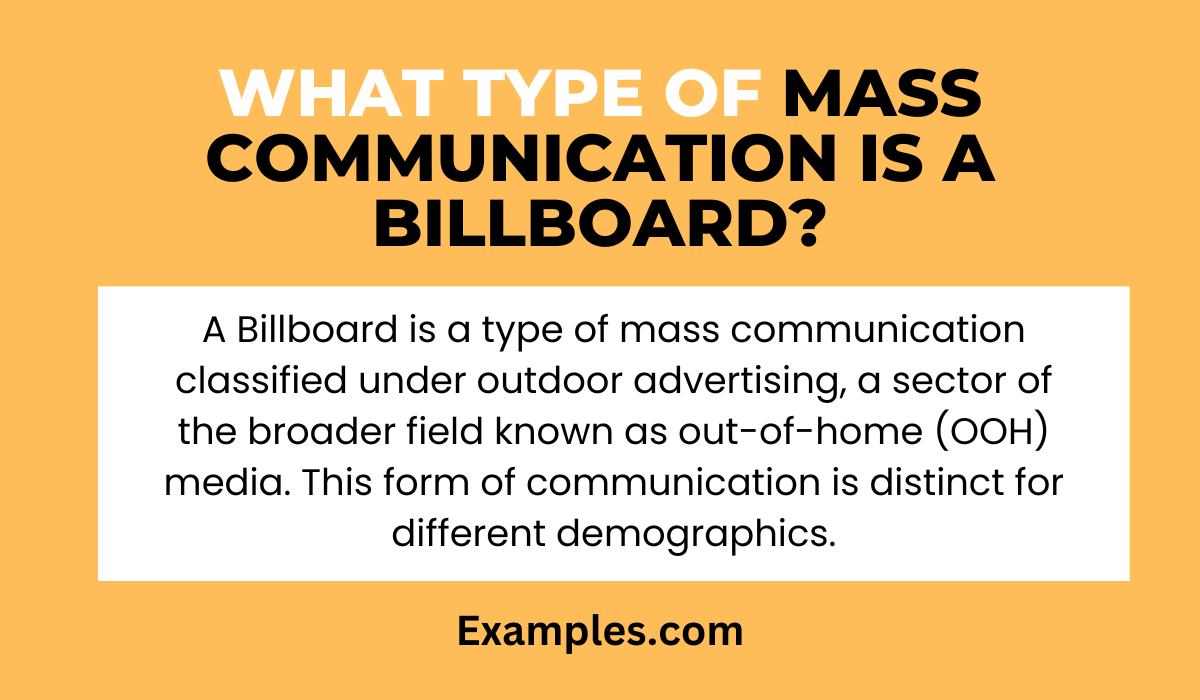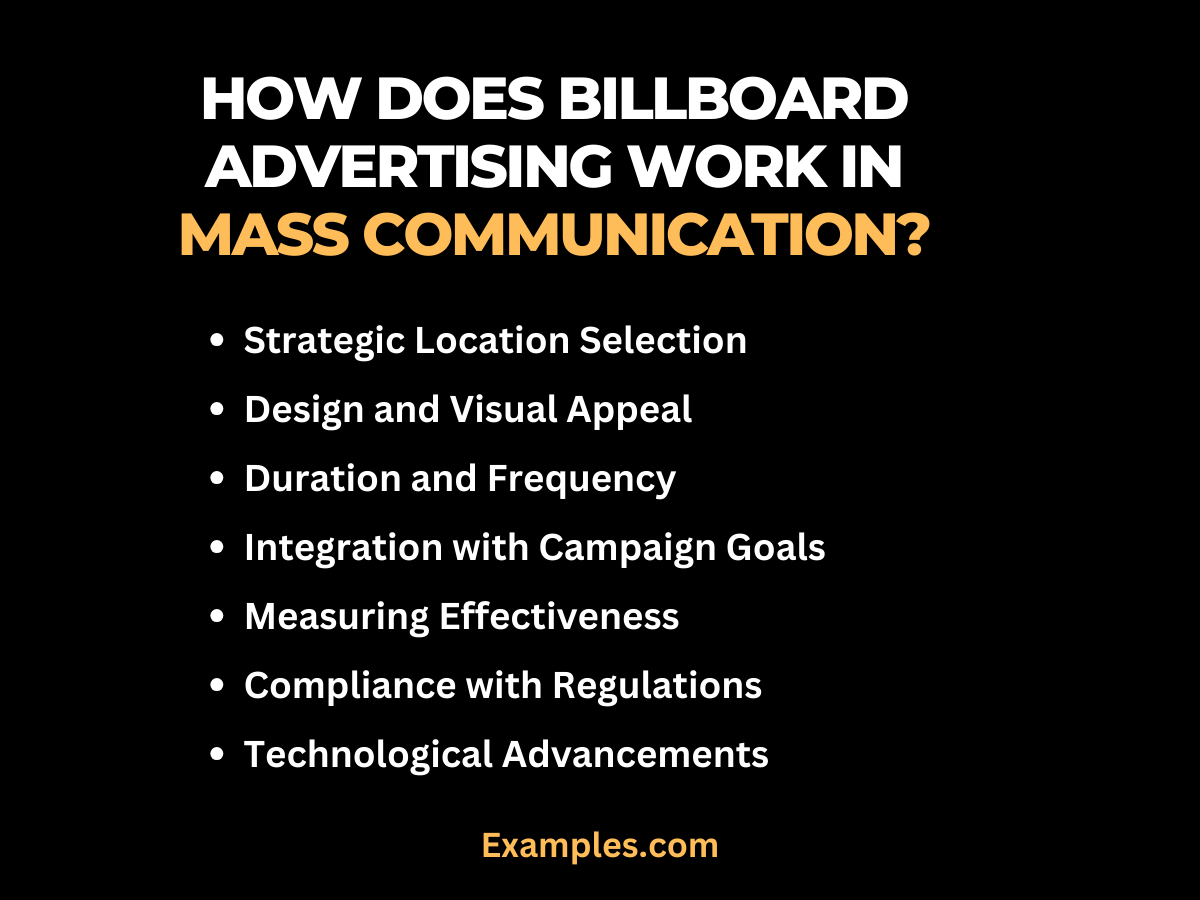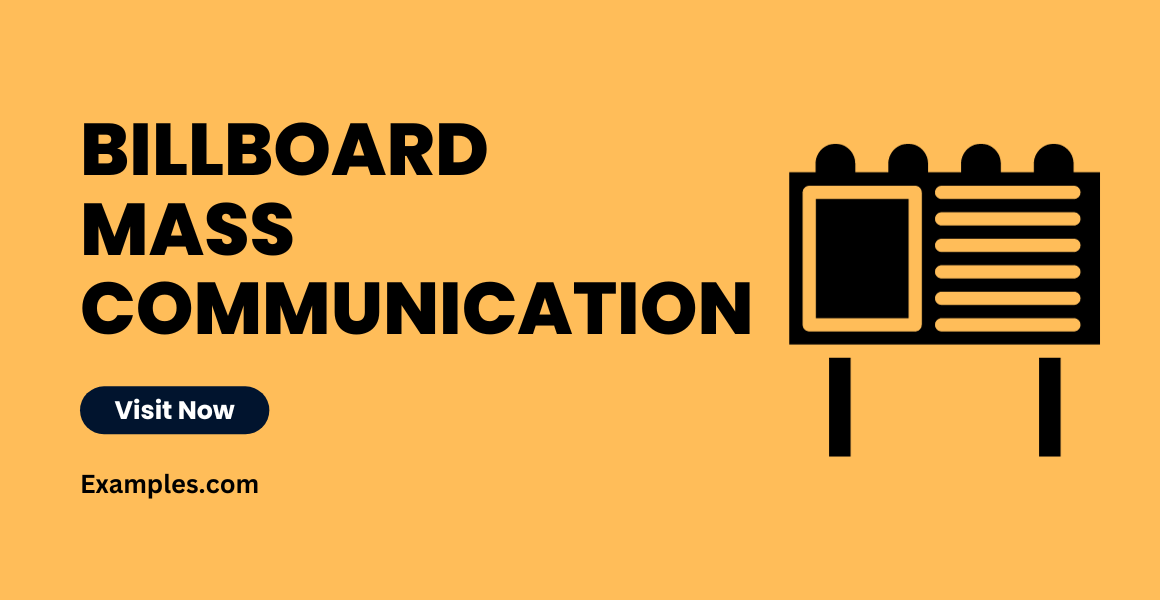Billboard Mass Communication
Billboard mass communication is an influential medium in the realm of outdoor advertising, offering unparalleled visibility and reach. This guide delves into the strategic use of billboards as potent tools for brand messaging and public outreach. With real-world communication examples, it illustrates how billboards can effectively capture attention, convey messages, and leave lasting impressions. From bustling city centers to quiet highways, learn how to leverage billboard advertising to maximize impact and engage audiences in diverse settings.
What is a Billboard in Mass Communication?
A billboard in mass communication is a large outdoor advertising structure typically found in high-traffic areas, designed to capture the attention of passersby and motorists. It’s a form of outdoor media that provides a platform for businesses and organizations to convey their messages on a grand scale. Billboards are effective for brand exposure and are often used to promote products, services, events, or public campaigns. Their size and prominence make them an impactful tool for mass communication, reaching a broad and diverse audience.
What Type of Mass Communication is a Billboard?
A billboard is a type of mass communication classified under outdoor advertising, a sector of the broader field known as out-of-home (OOH) media. This form of communication is distinct for its large-scale, public nature and its ability to reach a wide audience across different demographics. Billboards are typically positioned in high-traffic areas, such as alongside highways or in busy city centers, making them an effective tool for mass exposure and brand visibility.

Key Characteristics of Billboard Communication
- Wide Reach: Billboards are visible to a large number of people, including both local residents and travelers, making them ideal for campaigns aiming for broad exposure.
- Non-selective Audience: Unlike targeted digital ads, billboards are non-discriminatory in their reach, presenting the message to all who pass by.
- Visual Impact: The large size and visual nature of billboards make them particularly effective for conveying messages through striking images and bold text.
- Location-Based Messaging: The effectiveness of a billboard can be enhanced by its location, targeting specific geographic or demographic groups.
Role in Mass Communication
- Brand Awareness: Billboards are often used for building or reinforcing brand awareness due to their prominent and recurring exposure to a wide audience.
- Public Campaigns: Governments and non-profit organizations utilize billboards for public service announcements and awareness campaigns due to their public and widespread reach.
- Product and Service Promotion: Businesses leverage billboards to promote products and services, capitalizing on their ability to catch the eye of potential customers in various locations.
Strategic Use in Modern Advertising
- Combination with Digital Strategies: In the digital era, billboards often complement online and social media campaigns, creating a cohesive cross-media marketing strategy.
- Adaptability and Innovation: Modern billboards have evolved to include digital screens, interactive elements, and creative designs that adapt to current advertising trends and audience preferences.
Billboards represent a powerful form of outdoor mass communication, offering unique advantages in terms of visibility, reach, and impact. They continue to be a vital component in integrated marketing and communication strategies, adapting to modern needs while maintaining their traditional appeal.
How Does Billboard Advertising Work in Mass Communication?
Billboard advertising is a key component in the realm of mass communication, offering a unique blend of high visibility and broad reach. Understanding how it functions can significantly enhance its effectiveness as a marketing tool.

Here’s a detailed guide on the working mechanism of billboard advertising in mass communication.
Strategic Location Selection
- High-Traffic Areas: Billboards are typically placed in areas with high footfall or vehicular traffic to maximize visibility.
- Target Audience Alignment: Choosing locations that align with the target audience’s demographics and habits is crucial for relevant exposure.
Design and Visual Appeal
- Eye-Catching Designs: The success of billboard advertising largely depends on creating visually appealing and memorable designs.
- Concise Messaging: Due to the brief exposure time, messages need to be concise, clear, and impactful.
Duration and Frequency
- Long-Term Exposure: Billboards usually display an advertisement for an extended period, ensuring repeated exposure to commuters and passersby.
- Frequency Planning: The frequency of billboard changes should align with the campaign goals and audience engagement strategies.
Integration with Campaign Goals
- Brand Awareness and Promotion: Billboards are highly effective for increasing brand awareness and promoting new products or services.
- Direct Response Encouragement: Some billboards include a call-to-action, encouraging immediate response such as visiting a website or a physical location.
Measuring Effectiveness
- Audience Reach Estimates: While direct measurement can be challenging, estimates based on traffic data can provide insights into audience reach.
- Campaign Impact Analysis: Combining billboard advertising with other marketing channels can help in evaluating its overall impact on the campaign.
Compliance with Regulations
- Legal Considerations: Adhering to local advertising regulations and zoning laws is essential for billboard placement.
- Ethical Standards: Maintaining ethical standards in content to ensure the public’s acceptance and positive brand association.
Technological Advancements
- Digital Billboards: The use of digital technology in billboards allows dynamic content updates and interactive features.
- Creative Innovations: Innovative approaches, such as 3D billboards and augmented reality integrations, can significantly enhance engagement.
Billboard advertising in mass communication is a powerful tool that, when used effectively, can greatly amplify a brand’s message and reach. Its ability to make a lasting impression through strategic placement, creative design, and alignment with broader marketing goals makes it an indispensable asset in any comprehensive advertising strategy.
What are the Advantages of Billboard in Mass Communication?
Billboards hold a significant place in the landscape of mass communication, offering unique advantages for advertisers and communicators.

Their role in outdoor advertising and public messaging is pivotal due to several key benefits:
High Visibility
- Strategic Placement: Located in high-traffic areas, billboards guarantee visibility to a large number of people, including both pedestrians and drivers.
- Size and Impact: The sheer size of billboards makes them highly noticeable and difficult to ignore, ensuring your message stands out.
Wide Reach
- Diverse Audience: Billboards reach a broad and varied audience, cutting across different demographics and consumer segments.
- Consistent Exposure: Unlike other forms of media, billboards are on display 24/7, offering continuous exposure to your message.
Brand Reinforcement
- Memorable Impressions: Billboards create strong visual impressions, making them effective for brand reinforcement and recall.
- Long-term Exposure: Long-running billboard campaigns can solidify brand presence in consumers’ minds over time.
Cost-Effectiveness
- Economical Over Time: Compared to other media, billboards can be a cost-effective option, especially considering the duration of exposure and the number of people reached.
- Efficient Spending: With billboards, advertisers can target specific locations, ensuring their message reaches the intended demographic.
Flexibility in Design
- Creative Freedom: Billboards offer vast creative potential to showcase eye-catching designs and innovative concepts.
- Adaptability: They can be used for a wide range of purposes, from product promotions to public service announcements.
Enhanced Impact with Technology
- Digital Billboards: Modern digital billboards offer dynamic content changes, interactive capabilities, and even real-time updates, enhancing engagement.
- Measurable Impact: Advances in technology also allow for better tracking and measurement of billboard effectiveness.
Complements Other Media
- Integrated Campaigns: Billboards work well in conjunction with other media, forming an integral part of a comprehensive marketing strategy.
- Cross-Promotional Opportunities: They can be used to direct audiences to other media platforms, like websites or social media pages.
Billboards in mass communication offer high visibility, wide reach, brand reinforcement, cost-effectiveness, design flexibility, enhanced impact with technology, and the ability to complement other media channels. These advantages make billboards a compelling choice for advertisers aiming to make a strong, lasting impression in the public sphere.
How to Measure Billboards in Mass Communication
Measuring the effectiveness of billboards in mass communication is crucial for evaluating their impact and return on investment. It involves analyzing various metrics to understand how well these outdoor advertisements are reaching and engaging the audience. Here are steps to effectively measure billboard effectiveness in the realm of outdoor advertising.
Step 1: Define Your Measurement Goals
- Objective Setting: Clearly define what you want to achieve with your billboard campaign, whether it’s brand awareness, product promotion, or driving traffic to a website or physical location.
- Key Performance Indicators (KPIs): Identify which metrics will best indicate the success of your billboard, such as impressions, engagement, or direct response.
Step 2: Estimate Impressions
- Traffic Count: Use traffic data to estimate how many people are likely to see the billboard. This data can be obtained from local transportation departments or private data providers.
- Visibility Adjustments: Consider factors like the location, billboard size, and viewer distance to adjust the impression count for more accuracy.
Step 3: Assess Engagement and Recall
- Surveys and Interviews: Conduct surveys or interviews with people in the billboard’s area to measure brand recall and engagement levels.
- Audience Feedback: Collect feedback from your target audience through social media or other channels regarding the billboard.
Step 4: Analyze Conversion Metrics
- Call to Action Response: If your billboard includes a call to action (like a website visit or a phone call), track the responses directly linked to the billboard.
- Sales Data Correlation: Correlate the timing of the billboard campaign with any changes in sales or website traffic to assess impact.
Step 5: Use Digital Integration
- QR Codes and URLs: Incorporate QR codes or unique URLs on the billboard to track digital engagement.
- Social Media Monitoring: Monitor any increase in social media activity related to the billboard, such as mentions or hashtags.
Step 6: Calculate Return on Investment (ROI)
- Cost Analysis: Compare the cost of the billboard campaign against the revenue or value of the achieved results.
- ROI Calculation: Calculate the return on investment to understand the financial effectiveness of the billboard.
Step 7: Compare with Other Media
- Cross-Media Comparison: Compare billboard performance with other media channels to understand its relative effectiveness.
- Integrated Campaign Analysis: If the billboard is part of a larger campaign, assess its contribution to the overall campaign success.
By following these steps, advertisers can gain a comprehensive understanding of how their billboards are performing in the context of mass communication. This data-driven approach allows for more strategic decision-making in future outdoor advertising endeavors.
Tips for Advertising Billboard in Mass Communication
Billboard advertising remains a powerful tool in mass communication, offering high visibility and the ability to reach a large audience. To maximize the effectiveness of billboard advertising, it’s essential to employ strategic planning and creative design. Here are some valuable tips for creating impactful billboard advertisements in the realm of outdoor advertising and mass communication.
Choose the Right Location
- High Traffic Areas: Select locations with high footfall or vehicular traffic for maximum visibility.
- Target Audience Proximity: Place billboards in areas frequented by your target demographic for more relevant exposure.
Make Design Impactful
- Bold and Simple Graphics: Use striking visuals that are easily recognizable even from a distance.
- Readable Text: Ensure text is large, clear, and minimal to be read quickly by passersby.
Craft a Clear and Concise Message
- Succinct Messaging: Convey your message in a few words. Billboards are glanced at briefly, so the message needs to be understood quickly.
- Call to Action: Include a strong call to action that prompts immediate response or recognition.
Leverage Branding Effectively
- Consistent Branding: Ensure your billboard aligns with your brand’s visual identity for better recall.
- Logo and Contact Information: Display your logo and contact details (like a website or social media handle) prominently.
Consider Timing and Duration
- Strategic Timing: Align the billboard advertisement with specific campaigns, seasons, or events for timely relevance.
- Optimal Exposure Duration: Determine the best duration for your billboard ad to stay up, balancing cost and exposure.
Use Technology and Innovation
- Digital Billboards: Consider using digital billboards for dynamic content and the ability to update messages easily.
- Interactive Elements: Explore interactive elements like QR codes to engage audiences further.
Measure Impact and Adapt
- Tracking Results: Use tracking methods like unique URLs or promo codes to measure the campaign’s effectiveness.
- Adapt Based on Feedback: Be ready to tweak your strategy based on audience response and feedback.
Be Ethically and Socially Responsible
- Respectful Content: Ensure the content is socially and culturally appropriate and does not offend.
- Environmental Consideration: Be mindful of the environmental impact, especially with digital billboards and lighting.
Implementing these tips in your billboard advertising strategy can significantly enhance your presence in the world of mass communication. By focusing on location, design, messaging, and innovative technology, billboards can serve as a potent medium for conveying your message to a wide audience, thereby strengthening your brand’s visibility and impact.



